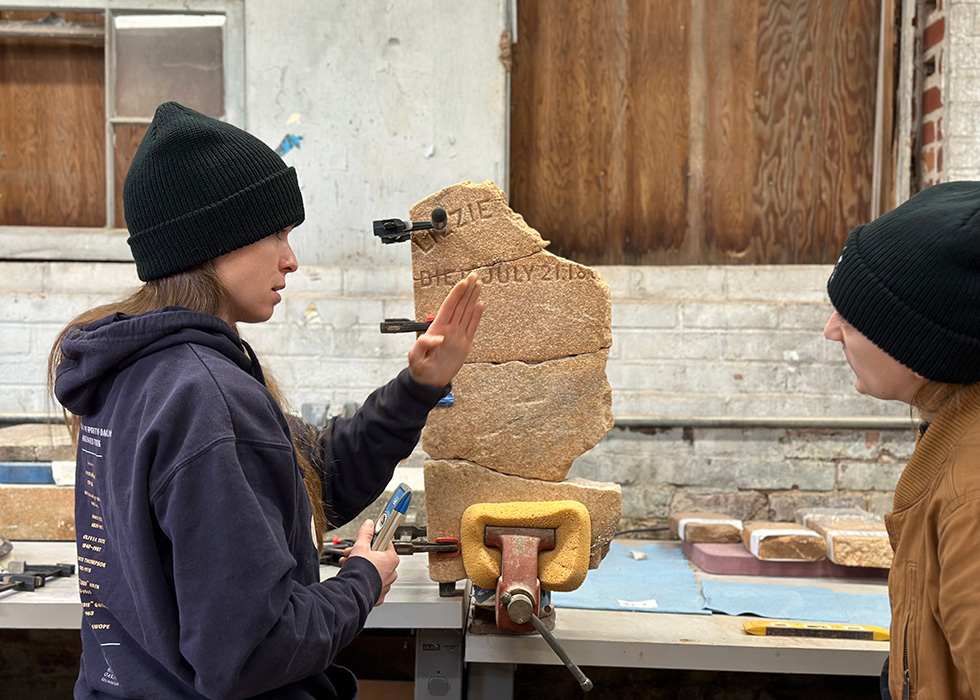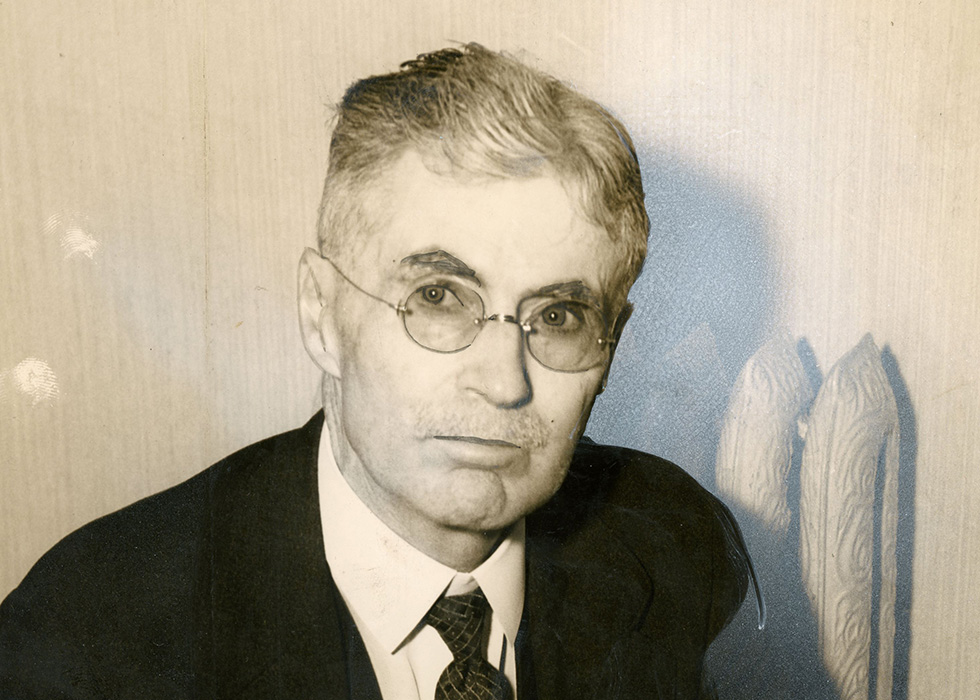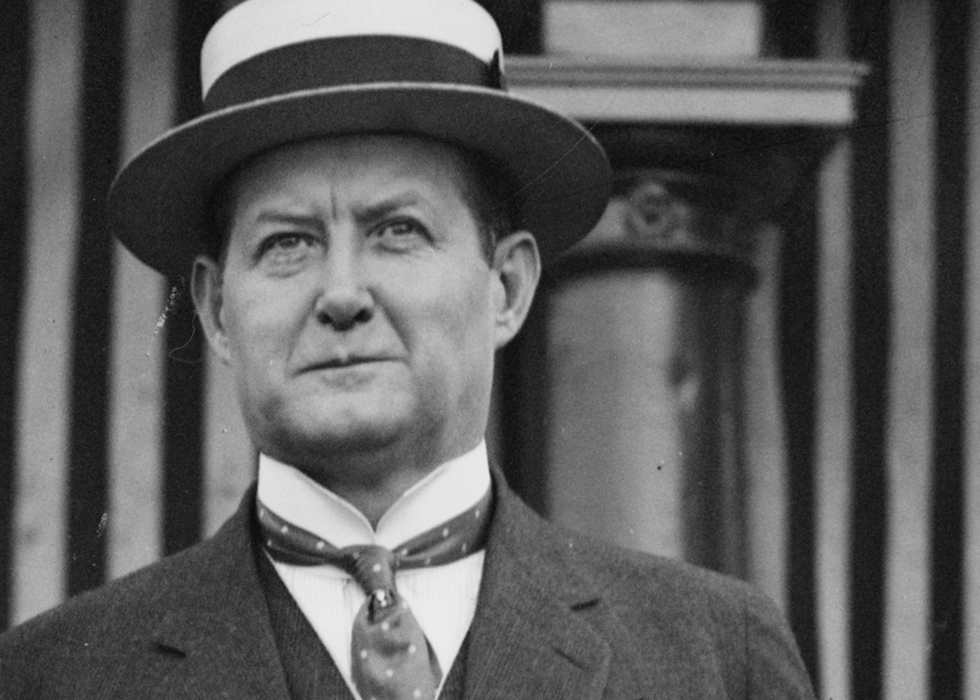
Faces of Oakland: Resident Memorials provide Rare Insight
by Sarah Zureick-Brown, Historic Oakland Foundation volunteer
Ambling through Oakland Cemetery is a great way to connect with past citizens of Atlanta. From the vast array of gravestones honoring the dead, we can learn the names of those who came before us, their dates of birth and death, and often the types of familial relationships they were recognized for in life (e.g., husband, wife, mother, father, sister, brother, child).
Occasionally, we’ll learn more by way of an epitaph, a short description etched on a gravestone (e.g., on the grave of Alton Demar “TeTe” Bowers you’ll find “He was a fool. But Julia loved him.”), or from the symbolism employed in a monument (e.g., a broken tree stump represents a life cut short). Very rarely, though, do we have the opportunity to find out about Oakland’s occupants what we might notice first about people we meet in life: what they looked like.
Although it is rare, there are residents of Oakland whose appearances we can learn more about because their visages have been incorporated in some way into their memorials. We’ll explore a handful of examples here, and you can search out more the next time you stroll through Oakland.
Oakland’s Unofficial and Slightly Informal Mayor
A great place to begin this virtual tour is with Jasper Newton Smith, an Oakland resident you’ll encounter almost immediately upon passing through the main gate, just to your right as you enter. Mr. Smith was an Atlanta businessman who operated a brickyard following the Civil War and invested in real estate including a building known as the “Bachelor’s Domain” because it was for men only.
Today, you’ll find a life-like statue of Mr. Smith sitting in a chair atop the entrance to his mausoleum, his gaze directed toward the West and coincidentally Oakland’s gate. This vantage point has earned him the title of Oakland’s unofficial mayor while the quality of the sculpture has earned the piece itself the distinction of being registered as a significant outdoor sculpture with the Smithsonian Institute (one of four such sculptures in Oakland).
If you spend enough time communing with Mr. Smith, one thing you’ll notice is that despite his formal Victorian attire (look at that beaver hat!), he seems to be missing a key wardrobe element: a tie. This is an intentional sartorial choice on the part of Mr. Smith for he despised neckties as a result of a near-strangulation experience in childhood.
Mr. Smith oversaw the construction of his mausoleum during his lifetime and made sure that the sculptor he commissioned for his statue did not make the same mistake a portrait artist once did: painting Mr. Smith with a much-reviled black scarf around his neck. It was reported that upon being shown this portrait, Mr. Smith kicked through the painting and refused to pay the artist for his work since he’d made such a grave error in depicting his subject.
Prior to his passing, Mr. Smith was known to visit his mausoleum at regular intervals. On one of these trips, he discovered that the ivy growing up the sides of his mausoleum had wound its way up his likeness and encircled his neck, mimicking a necktie. Enraged, he ordered the sexton of the cemetery to cut the ivy down in that instance and every time he returned and found the dreaded ivy creeping around his neck again.
Oakland’s present garden staff has continued to comply with his wishes, and you’ll note that Mr. Smith is happily both necktie and ivy free today. (See feature image above)
 My Bertha
My Bertha
The next stop on our virtual Faces of Oakland tour is on the Southeastern side of the cemetery in a section known as Jewish Hill. Keep an eye out to your left as you walk uphill on the path that traces the wall along Memorial Drive. Just past the Elsas Mausoleum, you’ll find the Wellhouse family lot where there’s a grave featuring a stone bust of a woman whose face appears to be emerging from a scroll that’s unfurling. Beneath her image, there’s an inscription, “My Bertha.”
The Bertha in question is Mrs. Bertha Hirsch Wellhouse, wife of Mr. Louis Wellhouse. Born in New Orleans, she was a resident of Little Rock, Arkansas when she married Mr. Wellhouse. They made their home in Atlanta and traveled together through Europe.
In February 1890, when Mrs. Wellhouse was 20 years old, they threw a glamorous house party with every fine detail related in an Atlanta Constitution article that declared “[n]ever in the history of Atlanta society has an entertainment been given that was more enjoyable or arranged and managed in better taste than the reception given by Mr. and Mrs. Louis Wellhouse.”
One hundred guests arrived to find Chinese lanterns illuminating the outside of the home while inside they were awed by stunning floral displays including a large “W” suspended from an arch between the parlors and decorated with climbing roses and a white dove on either side. Guests dined on a sumptuous feast that included salads, meats, cakes, and creams served in rinds of the fruits they were made from (e.g., orange in orange rinds). There were wells of champagne punch, and ices were served in French imported papier-mache cups. An orchestra provided live music, and there was dancing until midnight, at which point they distributed an assortment of party favors including Chinese and Japanese curios. Similar to fashion coverage today, it was not uncommon for newspapers at the time to report what women wore to parties, and so we know that for this event Mrs. Wellhouse wore a white satin gown embroidered with pearls that she accessorized with diamond jewelry.
Mrs. Wellhouse passed away at age 22, the mother of two children who were only three years old and ten days old when she died. In her funeral announcement, the Atlanta Constitution reported “[n]o death has brought to Atlanta more genuine sorrow than this, cutting short, as it does, a sweet young life.”

The Inman Children and Their Unusual Masks
Our next stop is the Inman family lot, located in East Hill, just a few blocks up from Mrs. Wellhouse and near the main paved road that runs east to west through this section. Look out for a large rectangular stone that says Inman and two cherub monuments positioned at the entrance to the lot. The Inmans were pioneer settlers of Atlanta and went on to become one of the wealthiest families in Georgia. Hugh and Louise, who the cherub monuments are dedicated to, were the children of Hugh T. and Josephine Inman.
Both Hugh and Louise died in childhood, Louise at age four-and-a-half and Hugh before his second birthday. Louise’s sudden death from gastric fever was announced in the Atlanta Constitution where they also noted her sweetness, intelligence, and ability to endear herself to older persons. From an article that appeared about a month prior to her death, we know that Louise, wearing a dress of pure white, attended a fifth birthday party with about sixty other children where the young guests played pin the tail on the donkey, ate strawberries with sugar, and received as a party favor a gold-rimmed china cup inscribed with their names and filled with French candies.
Hugh and Louise’s monuments are full of symbolism. Hugh’s cherub stands above a bed of rocks, which represents a life built on a firm foundation, and he pulls back a mantle to reveal a casket, which represents hope for eternal life. Louise’s cherub stands in front of a broken tree stump indicating a life cut short, and she writes on a stone tablet the brief story of her life.
During the period that Louise and Hugh lived (around the 1880s), death in childhood was a more common occurrence. In fact, it is estimated that children represent over one-third of burials in Oakland. A walk around Oakland will reveal other cherub monuments similar in style to Louise and Hugh’s, but we have reason to believe that the Inman figures are unique because it is said they were sculpted with the help of death masks made of the children’s faces after they passed.

In Memory of My Wife
Our next stop is on the northern side of the cemetery behind the Bell Tower in the section known as Bell Tower Ridge. One block parallel to and removed from the main road that connects the Bell Tower and the Richards Mausoleum, look for a tall monument with an urn on top that’s partially covered by a cloth. Additional drapery rests over the column the urn sits on. Columns, urns, and drapery are common motifs in cemeteries, and you’ll find similar monuments at Oakland—what makes this particular monument unique, however, is that beneath the column on the die, you’ll find the delicately chiseled face of Mina Thibadeau and a dedication, “In memory of my wife.”
This dedication is similar to the one we observed on Mrs. Wellhouse’s grave, and that’s not all these two women have in common. Both were mothers—Mrs. Thibadeau of eight children. Both women passed away in 1892, and their monuments were carved by the same artist–local Atlanta sculptor George Crouch, who also completed the ornamental work on the Georgia State Capitol.
One distinctive element of the sculpture of Mrs. Thibadeau is that she’s been depicted with her hair down in a natural style. This would have been atypical of everyday life in the period but was reflective of the artistic trends at the time, which incorporated natural elements like rocks, trees, plants, and flowers into design.
Mrs. Thibadeau was married to Mr. Joseph H. Thibadeau, who was a freight auditor for the Western and Atlantic railroad and also a supervisor in Georgia for the 1890 Census. You’ll note that Mr. Thibadeau does not appear to be buried in the same lot. Following Mrs. Thibadeau’s passing, Mr. Thibadeau eventually moved to Virginia, and in 1903, he died by suicide in a Washinton D.C. hotel claiming in a note he left that there was a conspiracy against him. He also asked in that note to be buried at Arlington Cemetery for he was a native of Maine and had served as a captain in the Union Army during the Civil War.
 A Visionary Mayor of Atlanta
A Visionary Mayor of Atlanta
Our last stop is back near the main entrance in the open lawn known as the North Public Grounds. This area was part of the original six acres of the cemetery, and as with most greenspace in Oakland, this is not available land but rather a space where paupers were buried without headstones. You, however, will be looking for a grave marker—an impressive 14.5-foot, 14-ton monument made of black granite, situated in the northwestern corner of the lawn. On the front of this monument, you’ll encounter the face of one of Atlanta’s longest-serving and most accomplished mayors: Mayor Maynard Jackson. Note that with the angle of the monument, Mayor Jackson appears to be looking out over the Atlanta skyline.
Mayor Jackson was the first African American elected mayor of Atlanta, and in total, he served three terms (1974-1982; 1990-1994). During his tenure, he worked to expand the airport, which is named Hartsfield-Jackson in his honor, and he helped bring the Summer Olympics to Atlanta in 1996. He also worked to advance equal opportunity for all. In particular, he made it easier for minority-owned businesses to work with the City and significantly increased the percentage of municipal contracts awarded to minorities and women during his administration.
You’ll find ivy growing around the base of Mayor Jackson’s monument. This ivy appeared spontaneously, and unlike the case of Mr. Smith, the plant has been welcomed as it symbolizes strength, endurance, and determination, which are traits consistent with Mayor Jackson’s character. As the epitaph on Mayor Jackson’s monument testifies, “his honor, courage, and vision created a new Atlanta.”
Mayor Jackson’s monument was designed by his wife, Valerie Jackson and her brother, Monte Richardson, a visual artist. Mrs. Jackson sees the monument not only as a testament to Mayor Jackson’s public accomplishments but also as a testament to their love and devotion to each other.
More Faces
There are more faces to find in Oakland and many more stories to hear. As we’re fond of saying, with over 70,000 residents of the cemetery, there’s no shortage of tales to tell.



